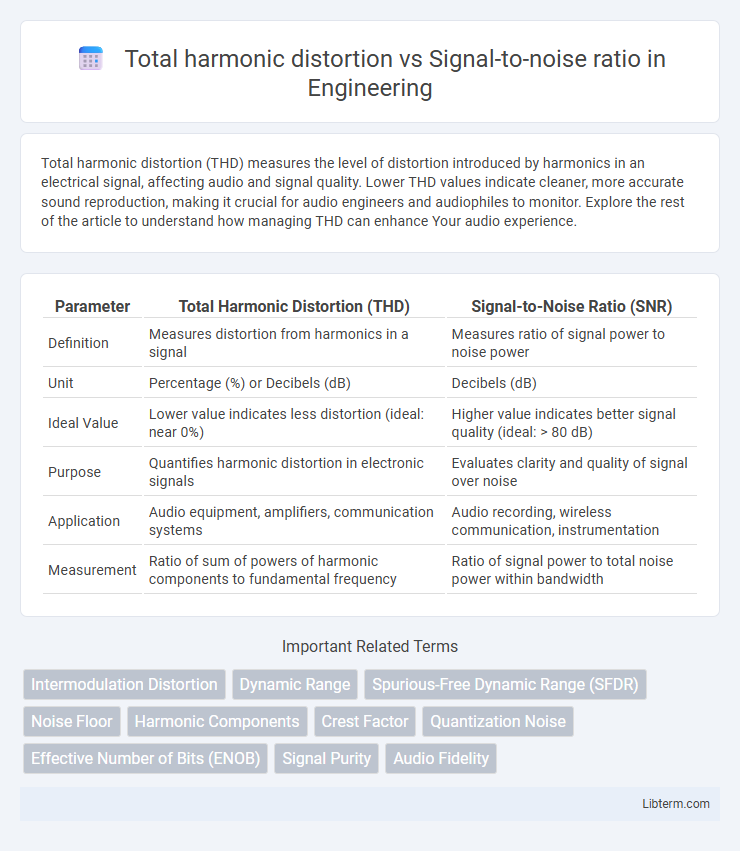Total harmonic distortion (THD) measures the level of distortion introduced by harmonics in an electrical signal, affecting audio and signal quality. Lower THD values indicate cleaner, more accurate sound reproduction, making it crucial for audio engineers and audiophiles to monitor. Explore the rest of the article to understand how managing THD can enhance Your audio experience.
Table of Comparison
| Parameter | Total Harmonic Distortion (THD) | Signal-to-Noise Ratio (SNR) |
|---|---|---|
| Definition | Measures distortion from harmonics in a signal | Measures ratio of signal power to noise power |
| Unit | Percentage (%) or Decibels (dB) | Decibels (dB) |
| Ideal Value | Lower value indicates less distortion (ideal: near 0%) | Higher value indicates better signal quality (ideal: > 80 dB) |
| Purpose | Quantifies harmonic distortion in electronic signals | Evaluates clarity and quality of signal over noise |
| Application | Audio equipment, amplifiers, communication systems | Audio recording, wireless communication, instrumentation |
| Measurement | Ratio of sum of powers of harmonic components to fundamental frequency | Ratio of signal power to total noise power within bandwidth |
Understanding Total Harmonic Distortion (THD)
Total Harmonic Distortion (THD) quantifies the distortion introduced by harmonics in an audio or electronic signal, expressed as a percentage of the fundamental frequency. It directly impacts audio clarity by indicating how much unwanted harmonic content is present, which can degrade sound quality. THD differs from Signal-to-Noise Ratio (SNR), which measures the level of the desired signal relative to background noise, focusing on clarity rather than harmonic distortion.
What Is Signal-to-Noise Ratio (SNR)?
Signal-to-Noise Ratio (SNR) measures the level of a desired signal relative to the background noise, typically expressed in decibels (dB). Higher SNR values indicate clearer audio or data transmission by reducing interference from unwanted noise. SNR is crucial in evaluating audio quality and system performance, often compared with Total Harmonic Distortion (THD) to assess overall signal fidelity.
How THD and SNR Impact Audio Quality
Total Harmonic Distortion (THD) and Signal-to-Noise Ratio (SNR) are critical metrics in assessing audio quality, where lower THD values indicate less distortion and cleaner sound reproduction. A higher SNR represents a greater difference between the audio signal and background noise, resulting in clearer and more accurate sound. Together, minimizing THD and maximizing SNR ensure high-fidelity audio by preserving the integrity of the original signal and reducing unwanted noise artifacts.
Key Differences Between THD and SNR
Total harmonic distortion (THD) measures the percentage of harmonic distortion present in an audio or electronic signal, indicating the extent to which the output deviates from a pure input waveform. Signal-to-noise ratio (SNR) quantifies the level of the desired signal relative to the background noise, expressed in decibels (dB), highlighting the clarity and quality of the signal. The key difference lies in THD representing distortion components created by the system, whereas SNR focuses on differentiating the signal from unwanted noise, both critical for evaluating audio fidelity and electronic performance.
Measuring Total Harmonic Distortion
Measuring Total Harmonic Distortion (THD) involves analyzing the harmonic frequencies generated by an audio signal compared to its fundamental frequency, providing a ratio that quantifies distortion levels. THD is expressed as a percentage or in decibels (dB), indicating the deviation caused by nonlinearities in audio devices such as amplifiers and DACs. This measurement is crucial for assessing audio fidelity, often contrasted with Signal-to-Noise Ratio (SNR), which evaluates the clarity by comparing desired signal power against background noise.
Measuring Signal-to-Noise Ratio
Measuring signal-to-noise ratio (SNR) involves comparing the level of the desired signal to the level of background noise, expressed in decibels (dB). Accurate SNR measurement uses a clean reference signal and a high-precision spectrum analyzer or audio analyzer to isolate noise components from the harmonic distortion present in the signal. While total harmonic distortion (THD) quantifies distortion components specifically, SNR provides a broader assessment of overall signal clarity by including all noise sources.
Real-World Examples: THD vs SNR in Audio Devices
Total Harmonic Distortion (THD) and Signal-to-Noise Ratio (SNR) are critical metrics in evaluating audio device performance, where lower THD ensures cleaner sound by minimizing distortion, and higher SNR indicates clearer audio with less background noise. In real-world examples, high-fidelity headphones often boast THD levels below 0.01% and SNR above 100 dB, delivering transparent and immersive sound experiences. Conversely, budget speakers may exhibit THD levels exceeding 1% and SNR values under 80 dB, resulting in noticeable audio distortion and background hiss that degrade listening quality.
Which Matters More: THD or SNR?
Total Harmonic Distortion (THD) measures the percentage of harmonic distortion present in an audio signal, reflecting how much the output deviates from a pure input waveform, while Signal-to-Noise Ratio (SNR) quantifies the level of the desired signal relative to background noise, expressed in decibels (dB). In audio quality assessment, SNR often matters more because a higher SNR ensures clearer sound by minimizing audible noise, whereas low THD primarily improves fidelity by reducing harmonic artifacts but can be less perceptible. Prioritizing SNR is crucial in environments with significant background noise or for recordings requiring high clarity, whereas THD gains importance in precision audio equipment where waveform accuracy is critical.
Reducing THD and Improving SNR
Reducing Total Harmonic Distortion (THD) enhances audio clarity by minimizing harmonic frequencies that distort the original signal, often achieved through high-quality components and precise circuit design. Improving Signal-to-Noise Ratio (SNR) increases the difference between the desired signal and background noise, typically by incorporating noise reduction techniques and shielding sensitive electronics. Optimizing both THD and SNR is crucial for superior sound reproduction in audio equipment, ensuring cleaner signals with minimal interference.
Selecting Equipment: THD and SNR Considerations
When selecting audio equipment, prioritize Total Harmonic Distortion (THD) levels below 0.01% for minimal sound coloration and clarity. Signal-to-Noise Ratio (SNR) values above 90 dB ensure cleaner audio reproduction by reducing background noise. Balancing low THD with high SNR is essential for achieving high-fidelity sound in professional and consumer audio devices.
Total harmonic distortion Infographic

 libterm.com
libterm.com